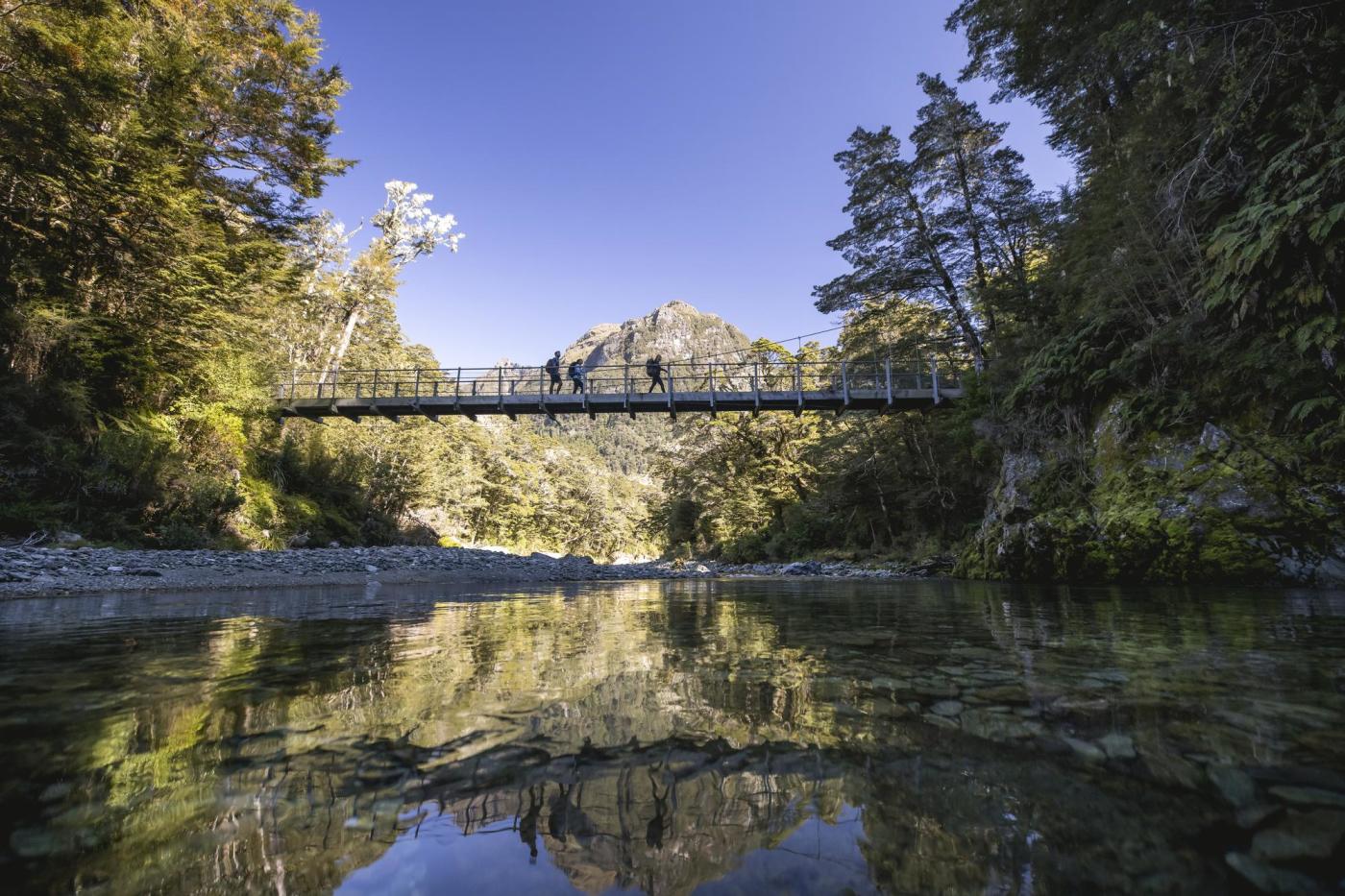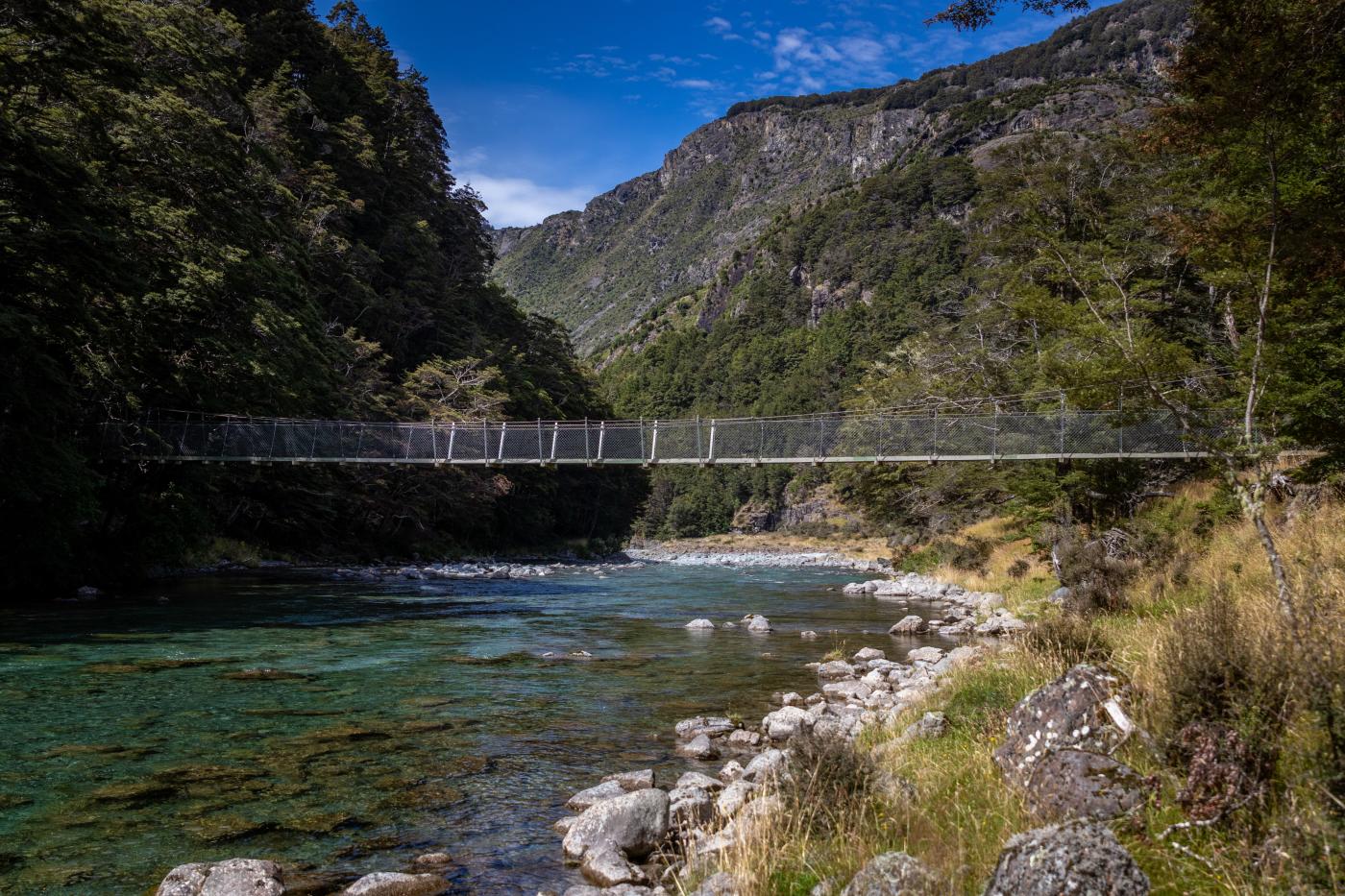Glenorchy is the gateway to Te Wāhipounamu, the Southwest NZ UNESCO World Heritage Area, 26,000km2 of wild mountainous terrain and fiords covered in ancient forest.
Not only is Te Wāhipounamu globally recognised as being of outstanding natural value. The region is also a playground for adventurers, with four of New Zealand’s Great Walks passing through the area. Explore this guide to the many ways to immerse yourself in the World Heritage Area’s unforgettable natural environment.
What makes Te Wāhipounamu so special?
World Heritage Areas are established to conserve nature and preserve culture. Sites may be exceptional ecosystems, culturally and historically significant, or both at once. There are only 1,199 World Heritage sites on the planet, and New Zealand is home to three: Te Wāhipounamu, Tongariro National Park, and the New Zealand Sub-Antarctic Islands.
UNESCO describes Te Wāhipounamu as a primeval wilderness. The region is shaped by the Alpine Fault. Two vast tectonic plates collide, the pressure driving the Southern Alps thousands of metres high. Glaciers have carved the range of peaks into fiords, lakes, waterfalls, and dramatic mountainous terrain.
Much of the region is covered with beech and podocarp forests, some trees over 800 years old. It’s home to plants and animals that were here back when New Zealand was part of the ancient supercontinent Gondwana, 80 million years ago. The forests are loud with bellbird, tūī, and kākā. The world’s only alpine parrot, the kea, lives here, as do three species of kiwi and the rare, endangered takahē.

Glenorchy
Ways to explore the World Heritage Area
Named for Te Wāi Pounamu, which means the greenstone waters in Te Reo Māori, the Te Wāhipounamu region encompasses four national parks: Westland Tai Poutini, Aoraki/Mount Cook, Mount Aspiring, and Fiordland.
When you’re visiting Queenstown, your closest access point for Te Wāhipounamu is Glenorchy, which sits at the southern tip of Mount Aspiring National Park and the start of the Routeburn Track into Fiordland. Glenorchy is a magnificent 45-minute drive from Queenstown along the western arm of Lake Whakatipu. Hire an EV or book a ride with one of the local operators who provide transport to and from Glenorchy and its hiking tracks.
The Routeburn Track
One of New Zealand’s Great Walks, the Routeburn Track links Mount Aspiring and Fiordland National Parks and passes through the World Heritage Area. The track is 33 km long, and most hikers do it over three days, spending two nights at huts along the way. The mountainous trail climbs from Glenorchy through beech forest to alpine meadows. You’ll walk through wetlands and tussock country, pass beneath snowclad peaks, alongside mountain tarns, and see impressive waterfalls.
If you’re short on time, you can simply do the Routeburn Nature Walk, a taster of the trail, taking you on a peaceful 40-minute loop through beech forests with interpretation panels along the way to help you identify plants and birds. If you have a full day, the Routeburn Flats hike takes you on the first section of the Great Walk, as far as the first hut. It’s an easy-moderate day hike with wonderful views.
The Rees-Dart Track
Longer and more challenging than the Routeburn, the Rees-Dart Track into Te Wāhipounamu is a 63km multi-day hike for advanced hikers. The trail begins at Muddy Creek near Glenorchy. From there you’ll hike through forests, magnificent mountain scenery, and along glacier-fed rivers. Experienced walkers can take a side day trip from Dart Hut to the Dart Glacier or Cascade Saddle.
The trail takes four to five days and it’s recommended to walk the track between late November and the end of April due to significant avalanche risk in the winter months.
Guided Hikes
Walking with an experienced local guide is the best way to immerse yourself in the nature, wildlife, geology, and history of Te Wāhipounamu. Several excellent local operators offer guided hikes and track transport into the World Heritage Area.
Ultimate Hikes offers a three-day adventure on the Routeburn and the longer Grand Traverse starting by Lake Whakatipu and walking the length of the Greenstone and Routeburn Valleys, crossing the main divide of the Southern Alps twice on the way.
The Great Glenorchy Alpine Basecamp runs a range of guided trips into the World Heritage Area including hiking, ski touring, snowshoeing, mountaineering, and visits to glaciers. Helicopters can take you into high mountain zones and remote locations.
Dart River Adventures’ guided funyaking experience is a delightful way to see Te Wāhipounamu from the water. They take you upriver into the World Heritage Area on a jetboat, then you kayak back down with your knowledgeable guide.
 Routeburn Track
Routeburn Track
Immerse yourself in the glory of Glenorchy
Some of these spots aren’t technically in the World Heritage Area. But the plethora of short walks, day walks and multi-day hikes in and around Glenorchy are all just as magnificent.
Short Walks
Glenorchy Lagoon Walkway. A choice of short, relaxed loop tracks in the wetlands north of Glenorchy takes in birdlife and beautiful mountain views. Ideal for a picnic.
Invincible Gold Mine Track. This 5km climb combines beech and mānuka forest with mountain views and fascinating gold mining heritage.
 Glenorchy Lagoon Walkway
Glenorchy Lagoon Walkway
Day Walks
Glacier Burn Track. Climb this steep 7.2km trail through beech forest with abundant bird life to Glacier Basin and views of the Humboldt Mountains.
Lake Rere Track. This 14.3km loop track takes in the Greenstone River, Lake Rere, and Elfin Bay on Lake Whakatipu.
Mount Judah Track. A challenging 16.6km loop trail along old mining roads into tussock country, with panoramic mountain views and a couple of ramshackle mountain huts.
Earnslaw Burn Track. This difficult but rewarding 24.5km hike follows Earnslaw Burn through bush up to high country tussock terrain at the head of the valley where you can see the base of the glacier on Mt Earnslaw/Pikirakatahi. Some hikers prefer to camp overnight.
 Earnslaw Burn Hike
Earnslaw Burn Hike
Multi-day Walks
Greenstone-Caples Track. This four-to-five-day stunning loop track connects to the Routeburn. It starts at the Greenstone Shelter an hour from Glenorchy and follows the Greenstone and Caples rivers through grassy flats, beech forest, farmland, and a spectacular gorge. There are three huts along the track.
 Greenstone-Caples Track
Greenstone-Caples Track
Other Outdoor Adventures
Hiking isn’t the only way to reconnect with nature and enjoy the spectacular scenery of the Te Wāhipounamu region.
- Paradise Ziplines. An exhilarating eight-line zipline course with stunning views that runs through beech forest and over a mountain stream.
- Local horse trekking operators will take you out on horseback to explore the landscape around Glenorchy and hear stories of the region from local guides.
- Heli-bike into the Richardson Mountains near Glenorchy. Land on the slopes and ride historic mining trails down to the valley floor.
 Paradise Ziplines
Paradise Ziplines
Protect yourself and protect this special place
The World Heritage Region is one of the most rugged, untamed parts of New Zealand. You’ll be hiking through exposed, mountainous terrain with changeable weather. Stay safe and follow the New Zealand Land Safety Code. Plan My Walk is a handy app built by hikers to help you plan your hiking adventure. You can plot out the stages of your walk, compare routes, and decide where you’re going to stay. We’ve put together a guide to preparing for your hiking trip to help you be prepared physically and mentally and carry the right gear.
Many people are working to protect the Te Wāhipounamu region. The Department of Conservation cares for the rare populations of takahē and Haast tokoeka kiwi, monitors populations of native birds and lizards, and coordinates predator control. UNESCO identifies one of the main threats to the region as invasive species, including introduced game such as red deer, wapiti, chamois, and tahr, as well as possum, rabbits, mustelids, and rodents.
You can protect this special place by sticking to the trails, creating as little waste as possible, and disposing of all rubbish responsibly. Consider donating to local conservation initiatives. You can even volunteer for projects like tree planting and wild pine eradication while you’re here. Find out more about local environmental action at Love Queenstown.
